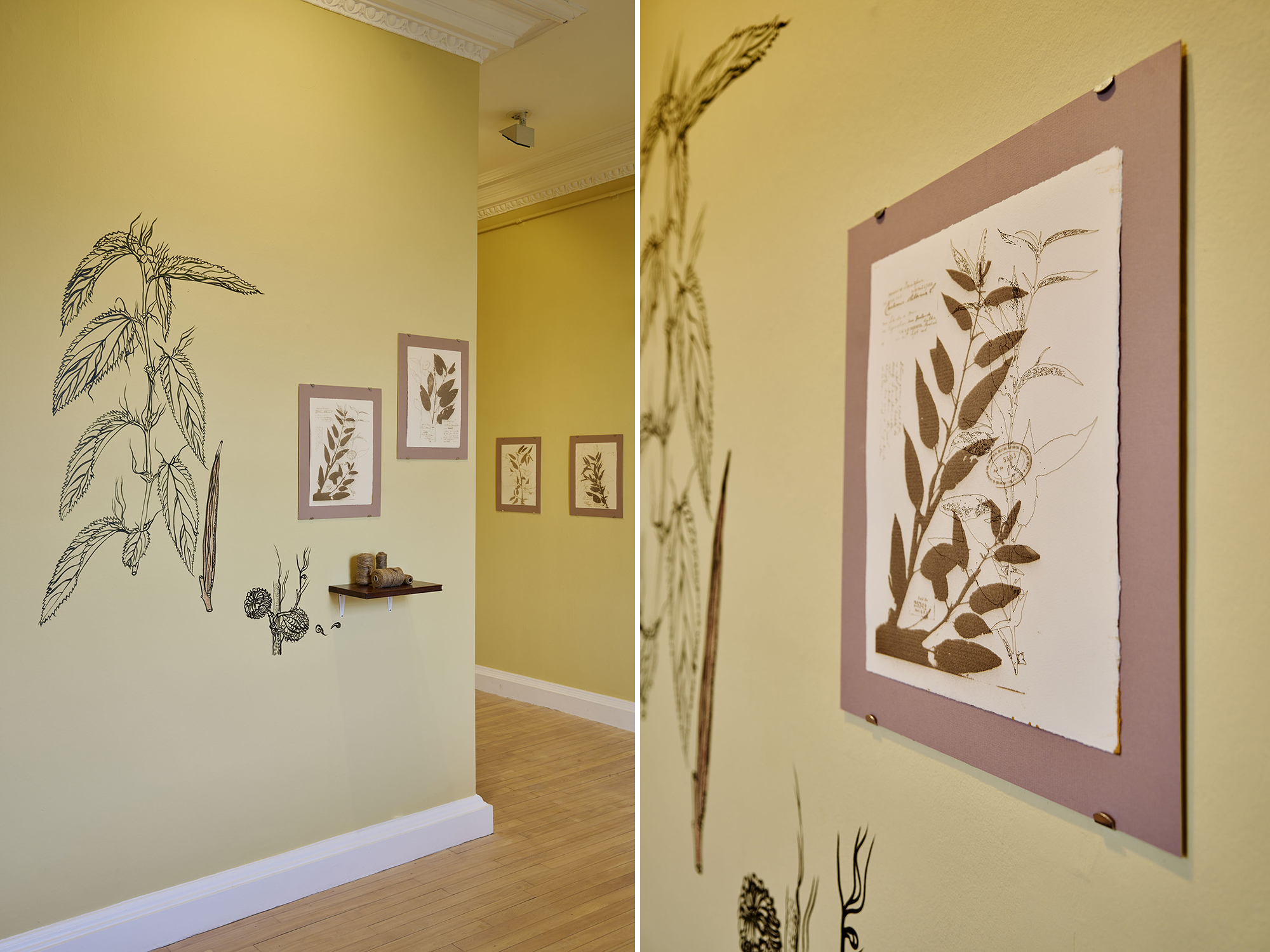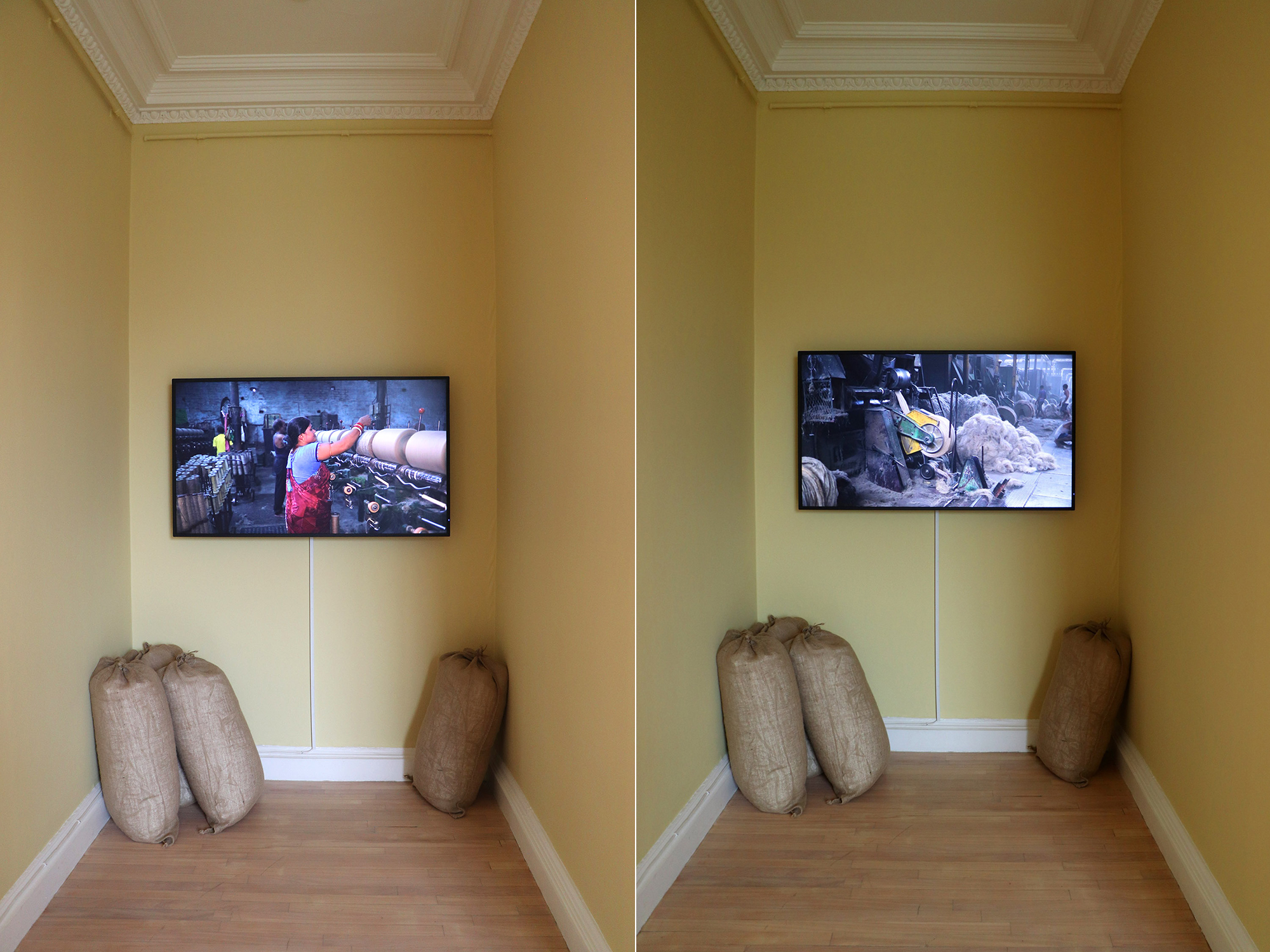

|
SILENT ARCHIVE CURATED BY EMMA NICOLSON INVERLIETH HOUSE MUSEUM ROYAL BOTANIC GARDEN, EDINBURGH Supported by the Outset Transformative Grant in partnership with Serpentine Galleries, London, Players of People's Postcode Lottery, and the National Lottery through Creative Scotland. 2024 | |
 A NOTE ON THE SERIES পাট, PAAT (JUTE): MEMORY, RESISTANCE AND ERASURE পাট, Paat (Jute): Memory, Resistance and Erasure is part of Sonia Mehra Chawla’s ongoing expansive new project with a focus on the history, contemporary crisis and future of the Jute Industry in Bengal. At the centre of the narrative are Kolkata (Calcutta) in West Bengal, India, where the artist was born and raised, and Dundee in Scotland, often called ‘Juteopolis, (accurately reflecting the extraordinary dominance of one economic activity in the city). Both cities and their environs and hinterlands prospered and thrived by the extraordinary dominance of the jute industry; both were devastated by jute; both were landscapes of the Empire. Sonia’s research objective is two-fold. She uses the globally marketed and consumed fibre, jute (Corchorus) as a trope to examine botanical histories and politics, and the complex socio-economic history of the working class and labouring population in colonial, post-colonial and contemporary Bengal. Secondly, she activates the notion of the material as a tool of resistance. Archives are often spaces of gaps and silences. Sometimes this is due to historical and internalized racism, classism, sexism, and ignorance of marginalized genders and sexualities. The project critically reflects upon archival silences and addresses questions such as- What is missing? Whose perspectives are not represented? What could be the reasons for these archival silences? Is there evidence for the missing perspective elsewhere (in another archives? in the community?) Employing an intersectional and multidisciplinary approach, this body of work examines the multifaceted relationship between colonial power and scientific knowledge, providing insights into botanical politics and conflicts, the often-overlooked histories of colonial capitalism, and the challenges of our possible future(s). Through her work, Sonia questions and destabilizes colonial legacies, constructs and entanglements, exploring new ways of seeing through embodied memories and labouring bodies. In her article ‘Future Imaginaries: For when the world feels like heartbreak’, historian Heather Davis talks about the re-imagining of a future where social and ecological justice are intertwined. She says, ‘Colonialism has always relied upon the complete transformation of the biosphere, the atmosphere and hydrosphere. Racial and environmental justice cannot be separated, but are part of an entangled matrix of capitalism and colonialism’. Such processes and legacies resonate strongly with recent discussions on the notion and controversies of the Anthropocene. The term ‘Anthropocene’ signifies the emergence of a new geological era resulting from human activities, but it is equally founded on haunting colonial legacies, proliferating environmental violences, the systematic erasure of legacies of violence and exclusion, including the erasure of racialized and gendered power dynamics. Contributing to recent discussions on the complexities of the Anthropocene and the dilemmas of the Plantationocene, this research might help visualize and envision more nuanced ways of re-counting and understanding plantation regimes, their afterlives and the various forms of resistance. | |
|
PAAT- RESEARCH AND COLLABORATION (2022-25) The research for this project has been facilitated by: British Council, India Charles Wallace India Trust Scholarships Royal Botanic Gardens, Edinburgh, University of Dundee Archives, UK University of Edinburgh, Library & Research Collections Bengal Biennale Foundation Beyond The Edge, Kolkata Botanical Survey of India, Howrah Indian Museum, Kolkata     |
|
| SILENT ARCHIVE AT INVERLIETH HOUSE, RBGE Painful truths, surprising revelations and fresh perspectives on humanity’s complex relationships with the botanical world emerge from our exhibition Silent Archive. International artists reveal RBGE’s archives in new ways, challenging us to discover hidden narratives and hear long-ignored voices that are preserved in our collections. Significant works that tell stories of scientific discoveries, colonial histories and cultural heritage are displayed for the first time. Plant artistry, photography, music and more help convey how these archives shape our view of history, whose past they represent and how they might inspire change. Silent Archive features material from RBGE’s collections alongside work from artists Amanda Cobbett, Amanda Thomson, Annalee Davis, Cynthia Fan, Hannah Imlach, Işık Güner, Jacqui Pestell, Janise Yntema, Karine Polwart, Laurie Clark, Pippa Murphy, Sarah Roberts, Sharon Tingey, Shiraz Bayjoo, Sonia Mehra Chawla and Wendy McMurdo. Silent Archive is supported by Players of People's Postcode Lottery, the Outset Transformative Grant in partnership with Serpentine Galleries, and the National Lottery through Creative Scotland. Click here to read about the exhibition    JUTE’S LONG AND TANGLED THREAD The story of jute stretches from India to Dundee, a noted centre for processing raw fibres into finished products. Links in the chain that connects them are colonial power, political struggle, identity, capitalism, ecology and botanical history. All of these things interest and influence Kolkata-born Sonia Mehra Chawla. But her works seek to offer different perspectives on them by asking fresh questions and teasing out hidden narratives-a new route to an alternate destination. Chawla’s multidisciplinary practice spans photography, filmmaking, drawing and installation. Among the work presented here is a film delving into the history of the Hastings Jute Mill in Hooghly, West Bengal, where jute is still milled on machines made in Glasgow, and new site-specific wall drawing. Complimenting Sonia Mehra Chawla’s work is a series of historical photographs, illustrations and postcards of jute cultivation and production in Bengal and Dundee in the 1800s and 1900s from the University of Dundee Archives. In addition, her work is displayed alongside archival illustrations, rare books, and herbarium specimens from the collection of the Royal Botanic Garden, Edinburgh.     EDITOR’S NOTES DECOLONIZING THE ARCHIVES The Library, Archives and Herbarium of the Royal Botanic Garden Edinburgh constitute a major collection of records, images, preserved specimens, and other materials relating to plants, plant species, and botanical research. As a living workspace it continues to extend its collections, while committing to improving free access for all. It serves as a repository of knowledge and information about plant biodiversity, taxonomy and ecology. Botanical archives play a crucial role in preserving historical data, aiding scientific research, and contributing to the understanding of plants and fungi. Decolonising the Archive involves addressing and rectifying historical and systemic biases, power imbalances, and colonial influences that may have shaped its content and representation. It ensures that diverse botanical knowledge systems and traditional ecological knowledge are acknowledged, valued, and integrated. This helps create a more holistic and accurate understanding of plants and their roles in different cultures and ecosystems. Royal Botanic Garden Edinburgh (RBGE) is a leading international research organisation delivering knowledge, education and plant conservation action around the world. In Scotland its four Gardens at Edinburgh, Benmore, Logan and Dawyck attract more than a million visitors each year. It operates as a Non-Departmental Public Body established under the National Heritage (Scotland) Act 1985, principally funded by the Scottish Government. It is also a registered charity, managed by a Board of Trustees appointed by Ministers. Its mission is "To explore, conserve and explain the world of plants."    পাট, PAAT (JUTE): MEMORY, RESISTANCE AND ERASURE A DECOLONIAL INSTALLATION WORKS পাট, Paat (Jute): The Labouring Body Film in high definition with sound Filmed on location at the Hastings Jute Mill, Rishra, Hooghly, West Bengal. Duration: 16 minutes, 20 seconds    Video stills from ‘পাট, Paat (Jute): The Labouring Body’ & installation view of Silent Archive at RBGE Started in 1875 with 230 looms by the Birkmyre Brothers, the Hastings Jute Mill was built on the sprawling estate of East India Company’s first Governor- General of Fort William in Bengal. Today, the Hastings Jute Mill remains one of India’s oldest operational jute mills. Like the over-a-century old Lancashire boiler – the 40-feet signature brick chimney and the associated early industrial legacy of the country – the East India Company remnants, and a wide jetty and the airbase bunkers are now witness to the historical vicissitudes. The over 3,000-worker-strong mill currently runs two shifts. Though surviving the odds of higher raw jute prices and lower realisations from the government orders, quintessentially Hastings represents the gloomy present of the ‘golden’ fibre textiles industry. (With excerpts from, ‘Hastings Jute Mill — rich past, fraying future’, by Jayanta Mallick, published in the Hindu Businessline, 2018) ঠাউর, স্থির দৃষ্টি The Gaze Installation with a photographic wall print, archival prints on Hahnemühle Fine Art Paper (Museum Etching), wooden frames, wooden shelf with assorted jute twine rolls, locally sourced from Bengal পাট, Paat (Jute): Corchorus studies Engraved and burnt drawings inspired by the colonial and post-colonial archives of the Royal Botanic Gardens, Edinburgh and the archives and research collections of the Botanical Survey of India (BSI) in Howrah শ্রমজীবী শরীর Labouring Bodies Jute cotton textile, print, natural jute stitched border, hand-crafted natural jute tassels and handmade wooden beads  Sonia Mehra Chawla, Artist's portrait by Neil Hanna Image credits- Royal Botanic Garden, Edinburgh. PLANTS AND PREJUDICE PONDERED THROUGH POWERFUL ART PUBLISHED ARTICLE, ROYAL BOTANIC GARDEN, EDINBURGH, 2024 The strange story of an enigmatic palm, misunderstood for more than 200 years, celebrated by a living wake, and finally accepted for what it was, stands at the core of a new art exhibition in Inverleith House Gallery at the Royal Botanic Garden Edinburgh. Beautiful, powerful, and thought-provoking, Silent Archive, features the work of 16 international artists who have taken their inspiration from the Royal Botanic Garden Edinburgh (RBGE) collections. In the opening room of the gallery, the haunting words of Karine Polwart, accompanied by the music of Pippa Murphy, set the backdrop for Wendy McMurdo’s vivid photography, plant cuttings, historic documents and a towering triptych created by RBGE’s own botanical artists, when a lofty 60 ft (18m) Sabal palm was dismantled in the Botanics’ Tropical Palm House four years ago. It is a poignant homage to the misjudged, setting visitors on a course of real-life human stories, coursing the centuries and reaching out from Dundee to Kolkata, Mauritius to Uist and beyond. Setting out to explore some difficult truths, historic ‘discoveries’ and fresh perspectives on human and plant relationships, Silent Archive shines fresh light on the complex links between the lives of jute workers in Kolkata today and the 19th century mill girls of Dundee’s notorious “Juteopolis” period. Equally revealing are the seldom told stories of the Scots banished to hard labour on the plantations of the Caribbean, and the French colonials who populated Mauritius with plants and people against their will. The ways plants learn to adapt to survive different living conditions, the modern-day impact of stress on our bees and the often-ignored worlds of cryptogams and fungi all bring extra layers of fulfilment to the narrative. Emma Nicolson, Head of Arts at RBGE, explained: “Our million plus visitors a year are well aware of our outstanding Living Collection of plants. But, we need to explain how our Archives are also alive in the day-to-day lives of our staff, students, volunteers, associates and partners around the world. By examining the preserved plants, handwritten journals and botanical artworks in these extensive Archives, we can build a clearer picture of the people representing RBGE over three-and-a-half centuries and their attitudes to world events happening in their midst. “While it sets out to re-contextualise the historical collections of a 354-year-old botanical institution, Silent Archive is brimming with a rich mix of human stories, and it is the power of art to inspire and make us think deeply that drives exhibitions like these. "In this remarkable showcase, our artists present their individual interpretations on the overwhelming need to foster discussion and encourage meaningful and healing dialogues within the art community and in wider society. Silent Archive aims to contest preconceived notions of botanical archives, while creating a space for diverse perspectives to interact and inspire positive action". The contributing artists are: Amanda Cobbett, Amanda Thomson, Annalee Davis, Cynthia Fan, Hannah Imlach, Işık Güner, Jacqui Pestell, Janise Yntema, Karine Polwart, Laurie Clark, Pippa Murphy, Sarah Roberts, Sharon Tingey, Shiraz Bayjoo, Sonia Mehra Chawla and Wendy McMurdo. click here to read the article     |